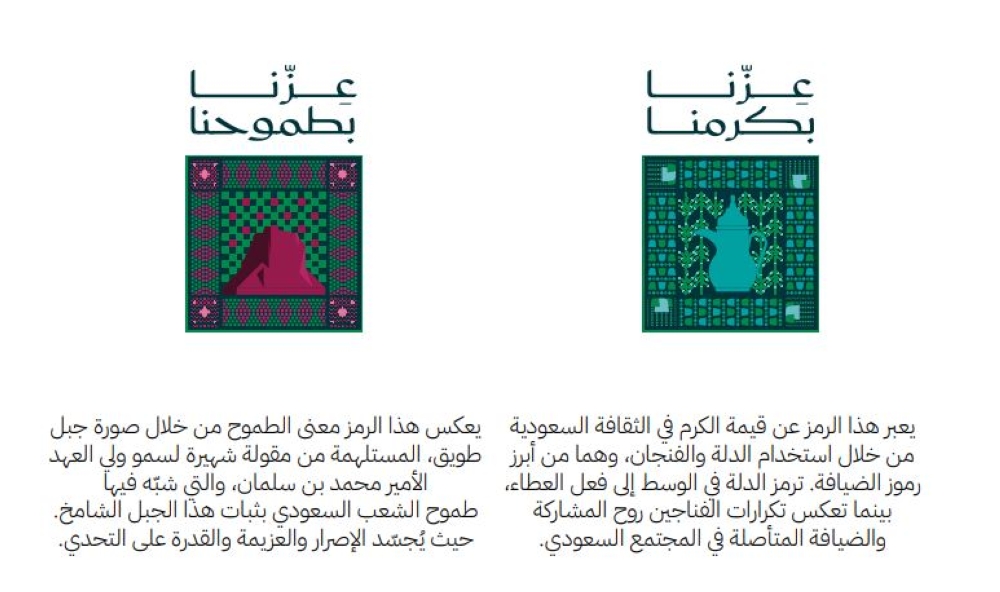The official identity for Saudi National Day 95 was unveiled yesterday, featuring the slogan «Our Pride is in Our Nature.»
The identity elements reflect the Kingdom’s heritage and vision, blending history, present, and future, while showcasing authentic Saudi attire for men and women in a modern style.
Strengthening National Belonging
This year’s identity aims to reinforce national belonging and pride in cultural heritage by promoting authentic societal values. Various regions are preparing to celebrate the occasion with events that reflect community unity and solidarity among citizens and residents, highlighting the significance of this occasion in national memory.
National Day Identity Typography
The typography was carefully selected to align with the National Day identity, ensuring brand consistency across all applications.
The font includes a variety of weights suitable for different uses.
Inspiration Behind the National Day Identity Graphics
The graphics were inspired by the authentic qualities and traits of the Saudi people, with six key characteristics chosen to represent the essence of national identity and community spirit.
Each characteristic is represented by a unique visual symbol reflecting its meaning and cultural value, with a distinct color scheme assigned to each symbol.
All government and private entities have been urged to use the official identity in all National Day applications, initiatives, and events. The full identity guidelines are available for download on the official National Day platform, including verbal and visual logos, official colors and typography, as well as creative patterns, illustrations, and templates suitable for media campaigns, souvenirs, and advertisements.
Authentic Saudi Traits
The slogan highlights the inherent qualities of the Kingdom’s people—generosity, ambition, courage, authenticity, and excellence—values reflected in their daily interactions and reinforcing the Saudi citizen as a symbol of pride. This underscores the ambitious vision driving the nation’s people toward success and building a future aligned with the country’s aspirations.
The launch of this year’s identity reinforces the spirit of belonging and embodies pride in heritage and authentic values that have shaped the Kingdom’s present and laid the foundation for its future.
National Day 95 Identity
«National Day 95 Identity» likely refers to a cultural or national celebration marking the 95th anniversary of a significant historical event, such as a country’s independence or founding. The event would emphasize national pride, unity, and historical reflection, possibly featuring ceremonies, exhibitions, or performances that highlight the nation’s heritage and achievements over 95 years. Specific details would depend on the country or context in which this celebration takes place.
Kingdom’s vision
«Kingdom’s Vision» is a cultural and entertainment landmark in Saudi Arabia, reflecting the nation’s ambitious goals under Vision 2030. It showcases the country’s heritage, technological advancements, and future aspirations through immersive experiences and exhibitions. The site symbolizes Saudi Arabia’s transformation and commitment to diversifying its economy and culture beyond oil.
Kingdom’s heritage
«Kingdom’s Heritage» refers to the rich cultural and historical legacy of a nation, often encompassing ancient monuments, traditions, and artifacts that reflect its royal past. For example, in Saudi Arabia, the «Kingdom’s Heritage» includes sites like Diriyah, the original home of the Al Saud dynasty and a UNESCO-listed hub of Najdi architecture. Such heritage preserves the identity and historical narratives of a kingdom, offering insights into its governance, culture, and societal evolution over centuries.
authentic Saudi attire
Authentic Saudi attire reflects the Kingdom’s rich cultural heritage and Islamic traditions, with men typically wearing the *thobe* (a long white robe) and *ghutra* (headscarf), while women wear the *abaya* (a flowing black cloak) and often a *niqab* (face veil). These garments are designed for comfort in the desert climate and modesty in accordance with Islamic values. Traditional fabrics, embroidery, and regional variations, such as the colorful *Saudi hijaz dress*, showcase the diversity within Saudi Arabia’s cultural identity.
National Day identity
«National Day Identity» refers to the cultural and historical significance tied to a country’s National Day celebrations, often marking independence, revolution, or unification. These events reinforce national pride, unity, and shared heritage through symbols, traditions, and public ceremonies. For example, France’s Bastille Day (July 14) commemorates the 1789 revolution, while the U.S. Fourth of July celebrates independence from Britain in 1776.
official National Day platform
The **official National Day platform** is a central stage used during national celebrations, often for speeches, performances, and parades. Historically, such platforms have been symbolic sites where leaders address the public, reinforcing national unity and commemorating significant events, like independence or revolution. Their design and location may vary by country, but they typically serve as a focal point for patriotic ceremonies.
Saudi citizen
A Saudi citizen is a national of Saudi Arabia, a country with deep historical roots in the Arabian Peninsula, home to Islam’s two holiest cities, Mecca and Medina. The modern Saudi state was founded in 1932 by King Abdulaziz Al Saud, unifying various regions under a single monarchy. Saudi culture is strongly influenced by Islamic traditions, tribal heritage, and the country’s role as the birthplace of Islam and a global energy leader.
Kingdom’s people
«Kingdom’s People» appears to refer to a cultural or historical group, but without specific context, it may relate to a community tied to a particular kingdom or heritage. If referencing a cultural site, it could be associated with a historical kingdom’s traditions, artifacts, or descendants, such as those of ancient African, Asian, or European realms. For a precise summary, more details about the location or historical background would be needed.






